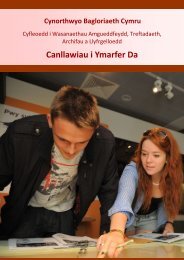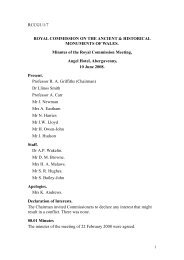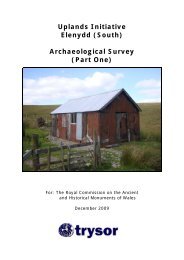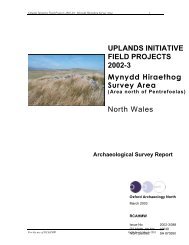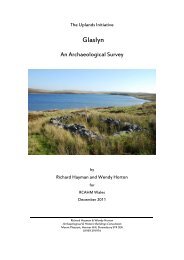Plynlimon (central) - Royal Commission on the Ancient and ...
Plynlimon (central) - Royal Commission on the Ancient and ...
Plynlimon (central) - Royal Commission on the Ancient and ...
You also want an ePaper? Increase the reach of your titles
YUMPU automatically turns print PDFs into web optimized ePapers that Google loves.
Upl<strong>and</strong>s Initiative – Nant y Moch & Pumlim<strong>on</strong> Fawr / <str<strong>on</strong>g>Plynlim<strong>on</strong></str<strong>on</strong>g> 2004With regards prehistoric sites, a possible cairn or else a former round hut was discovered in <strong>the</strong> north-westarea (NPRN: 282115) <strong>and</strong> a fur<strong>the</strong>r <strong>on</strong>e (NPRN: 282255) <strong>on</strong> <strong>the</strong> west banks. This latter <strong>on</strong>e is <strong>on</strong>ly small<strong>and</strong> may in fact be clearance, although kerb st<strong>on</strong>es do appear to be present.Previously recorded <strong>on</strong> <strong>the</strong> sou<strong>the</strong>rn banks of <strong>the</strong> reservoir was a possible cup marked st<strong>on</strong>e (NPRN:284133), but this was not located at <strong>the</strong> time of <strong>the</strong> field visit.Fur<strong>the</strong>r up <strong>the</strong> sou<strong>the</strong>rn slopes of <strong>the</strong> reservoir was discovered <strong>the</strong> remains of Lluest y Helfa <strong>and</strong> LuestFagwr Isgaf (NPRN: 282546 / 284074). Both <strong>the</strong> sites are in very poor c<strong>on</strong>diti<strong>on</strong> <strong>and</strong> very little remains tobe seen apart from grass covered wall <strong>and</strong> rubble remains.Area 3. Disgwylfa Fawr & Bryn GwynWith regards prehistory in this area, two br<strong>on</strong>ze age burial cairns (NPRN: 282862 / 282863) werediscovered just nor<strong>the</strong>ast of Llyn Syfyddrin reservoir <strong>on</strong> its nor<strong>the</strong>rn banks. Both <strong>the</strong>se were oval in form<strong>and</strong> each approx. 6m x 3m <strong>and</strong> 0.50m high. Accompanying <strong>the</strong>se two cairns was discovered a smallst<strong>and</strong>ing st<strong>on</strong>e very close by (NPRN: 282861). A fur<strong>the</strong>r st<strong>and</strong>ing st<strong>on</strong>e (NPRN: 282257) was also found in<strong>the</strong> area near <strong>the</strong> ruined farmstead of ‗Bwlchstyllen‘. This was quite small however, approx. 0.70m high x0.50m width. Not st<strong>and</strong>ing but a prominent st<strong>on</strong>e never<strong>the</strong>less was that of a boulder of white quartz (NPRN:282832) found <strong>on</strong> <strong>the</strong> north-east facing slope of Disgwylfa fawr, al<strong>on</strong>gside <strong>the</strong> edge of an old trackway orold packhorse track that ascends Disgwylfa Fawr. This st<strong>on</strong>e is likely a way-marker st<strong>on</strong>e marking <strong>the</strong> edgeof <strong>the</strong> trackway <strong>and</strong> can be seen from a distance in <strong>the</strong> mist. A series of st<strong>on</strong>e piles are also located al<strong>on</strong>g<strong>the</strong> edge of <strong>the</strong> forestry to <strong>the</strong> north, likely demarcating an old boundary line, possibly that opf Lluest HelfaLas to <strong>the</strong> north-east.On route to <strong>the</strong> ruins of Nant Glas House at <strong>the</strong> far north of Disgwylfa Fawr, is <strong>the</strong> possible remains of aburnt mound (NPRN: 282143). The mound is approx. 5m l<strong>on</strong>g x 2m wide <strong>and</strong> 1m high <strong>and</strong> located at <strong>the</strong>edge of stream.With regards <strong>the</strong> post medieval period, this area houses <strong>the</strong> remains of four deserted rural farmsteads, thatof ‗Syfyddrin‘ (NPRN: 282943), Nant Glas (NPRN: 284081) <strong>and</strong> Bwlchstyllen (NPRN: 282260) <strong>and</strong>‗Lluest y Cleehir‘ (NPRN: 282895). Each of <strong>the</strong>se sites is in complete ruin <strong>and</strong> unroofed. The bestpreserved <strong>and</strong> impressive of <strong>the</strong> three however is that of Bwlchstyllen, whose walls still st<strong>and</strong> in places toapprox. 2m high. All of <strong>the</strong> out buildings are also in ruin. As to ‗Syffyddrin‘, not much is left of hisfarmstead. St<strong>and</strong>ing remains <strong>on</strong> average are <strong>on</strong>ly approx. 1m high. With regards <strong>the</strong> lluest ‗Nant Glas‘, thissite sits <strong>on</strong> its own in a very secluded spot tucked up against an east facing slope. St<strong>and</strong>ing remains for thissite are approx. 1m high. Close to <strong>and</strong> associated with this lluest site, <strong>the</strong> field survey found a large squarebanked enclosure (NPRN: 282745). Just north-east of Nant Glas house, at <strong>the</strong> top of a ridge, <strong>the</strong> field surveyrecorded an area or a ‗pocket‘ of l<strong>and</strong> that appeared to be a natural topographic enclosed area, however<strong>the</strong>re was a vague trace of a possible low bank, implying that this area may have been used at some stage asa naturally formed enclosure, but with an enclosure bank to complete its character (NPRN: 282744).Whe<strong>the</strong>r this feature is c<strong>on</strong>temporary in date to Nant Glas or not is uncertain. Fur<strong>the</strong>r south from here <strong>the</strong>field survey also recorded <strong>the</strong> existence of a likely post medieval prospecting pit (NPRN: 282744).As to ‗Lluest y Cleehir‘, this site is located in a very secluded but impressive spot overlooking <strong>the</strong> Rheidolvalley. From <strong>the</strong> records of Lewis Morris <strong>and</strong> later estate maps <strong>and</strong> Ti<strong>the</strong> maps, it would appear that this sitebecame ab<strong>and</strong><strong>on</strong>ed at around <strong>the</strong> turn of <strong>the</strong> 19 th century, or at least before <strong>the</strong> Ti<strong>the</strong> Map of 1845, as it isnot scheduled in <strong>the</strong> apporti<strong>on</strong>ments. As such, this site is in a very poor state with grass <strong>and</strong> reedsoccupying much of <strong>the</strong> internal ground plan. The walls of <strong>the</strong> main lluest are approx. 1m high. The entrancefaces east. The site is enclosed by a large enclosure.When st<strong>and</strong>ing within <strong>the</strong> ruined farmstead of ‗Lluest y Cleehir‘ <strong>and</strong> looking south, a l<strong>on</strong>g curvingsubstantial grass bank is visible. Initially it appears that this is an impressive medieval enclosure bankcurving over <strong>the</strong> hillside <strong>and</strong> running down toward Disgwylfa Fach, however <strong>the</strong> OS 1 st editi<strong>on</strong> map impliesthat this bank may have had an associati<strong>on</strong> with <strong>the</strong> Aberystwyth Corporati<strong>on</strong> Water Works pipeline. This isuncertain <strong>and</strong> this bank needs to be investigated more thoroughly.71CAP Report No: 355




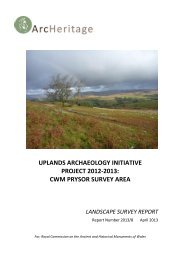
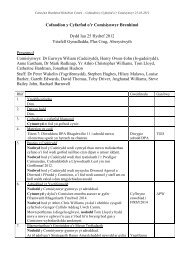
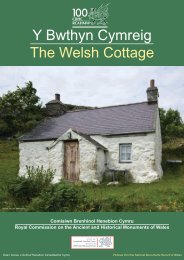

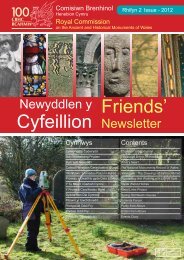
![The Source of the Usk Walk [2012 PDF]](https://img.yumpu.com/49285699/1/190x245/the-source-of-the-usk-walk-2012-pdf.jpg?quality=85)

